Charles E W Bean, Diaries, AWM38 3DRL 606/263/1 - 1916 - 1934 - Part 3
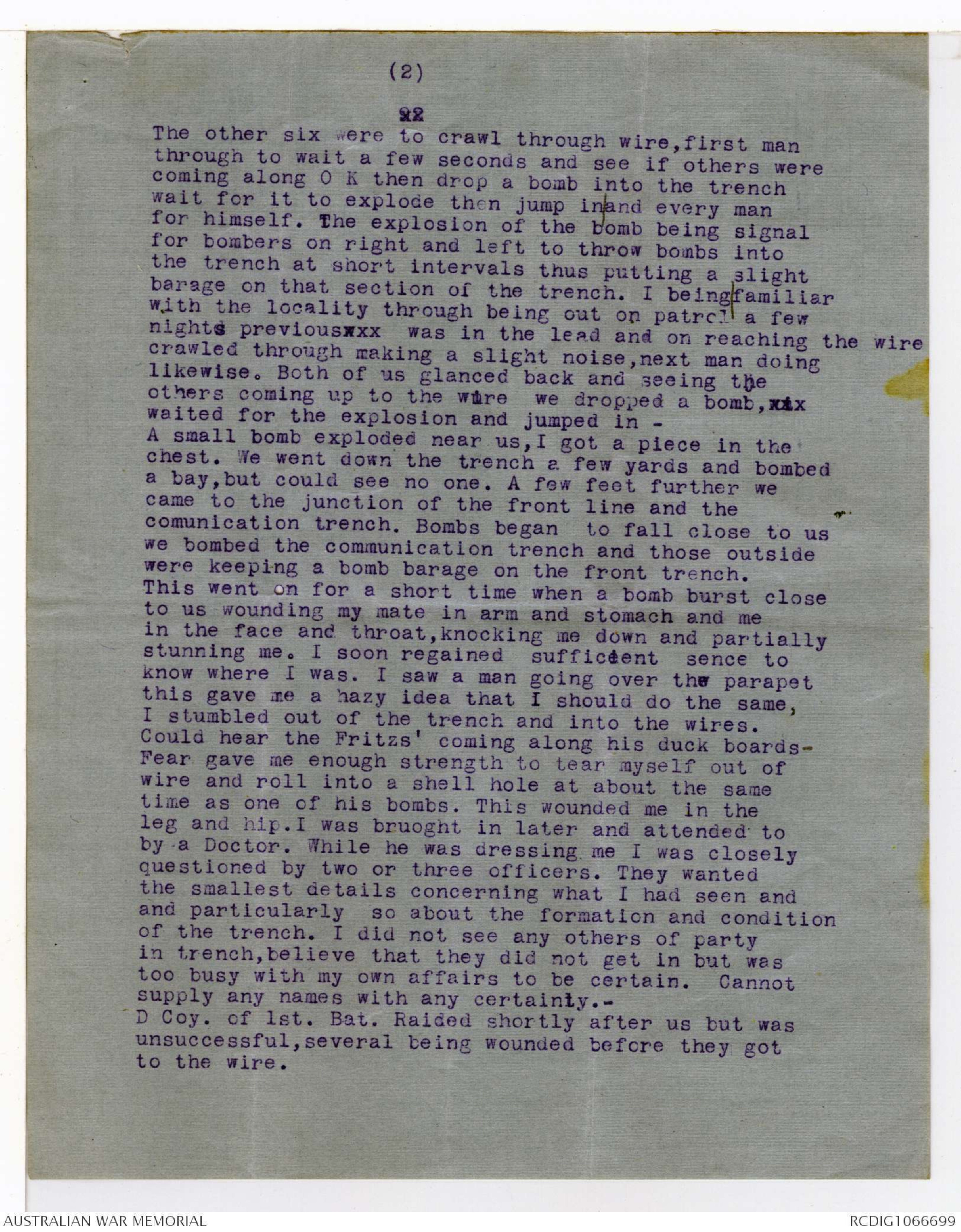
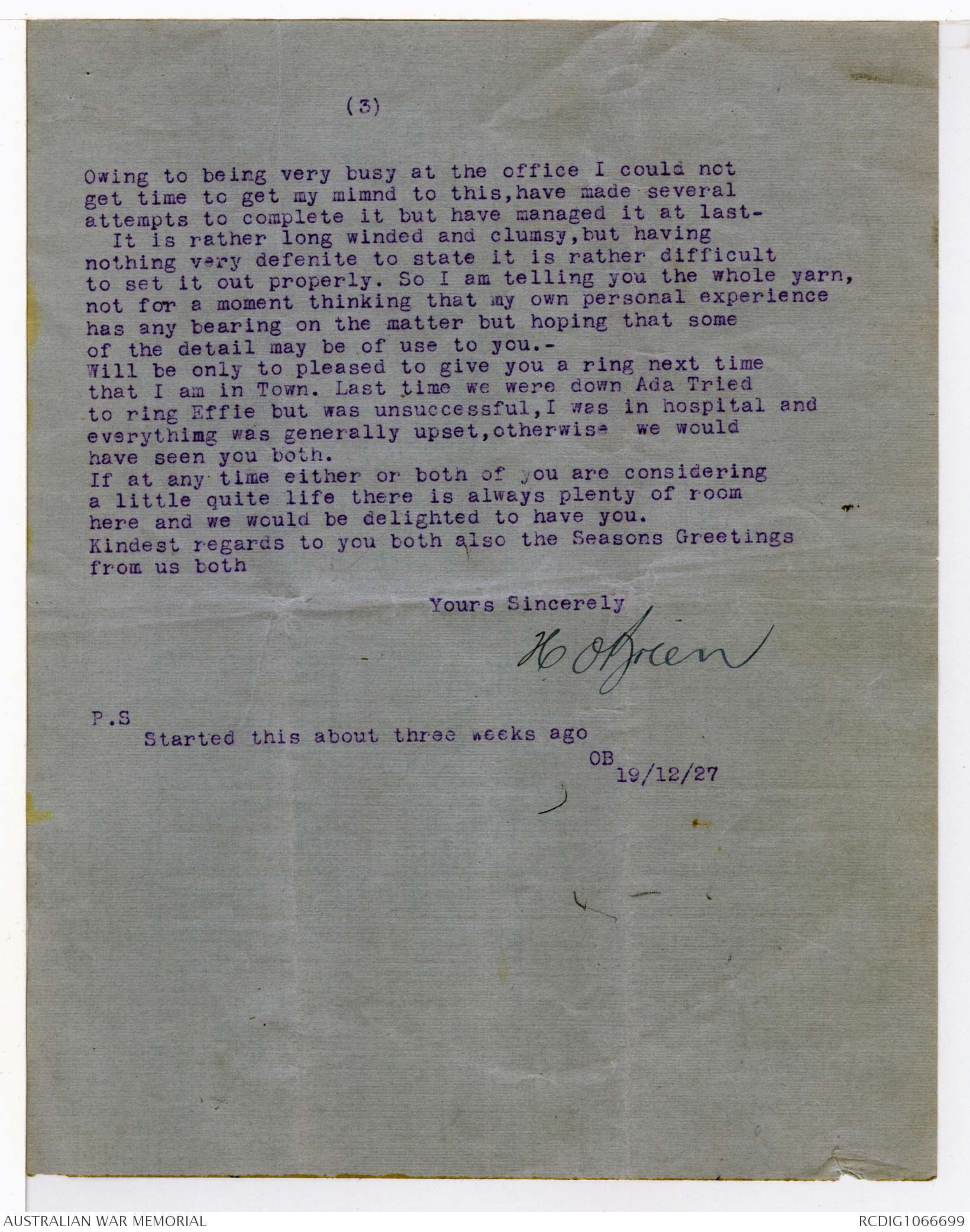

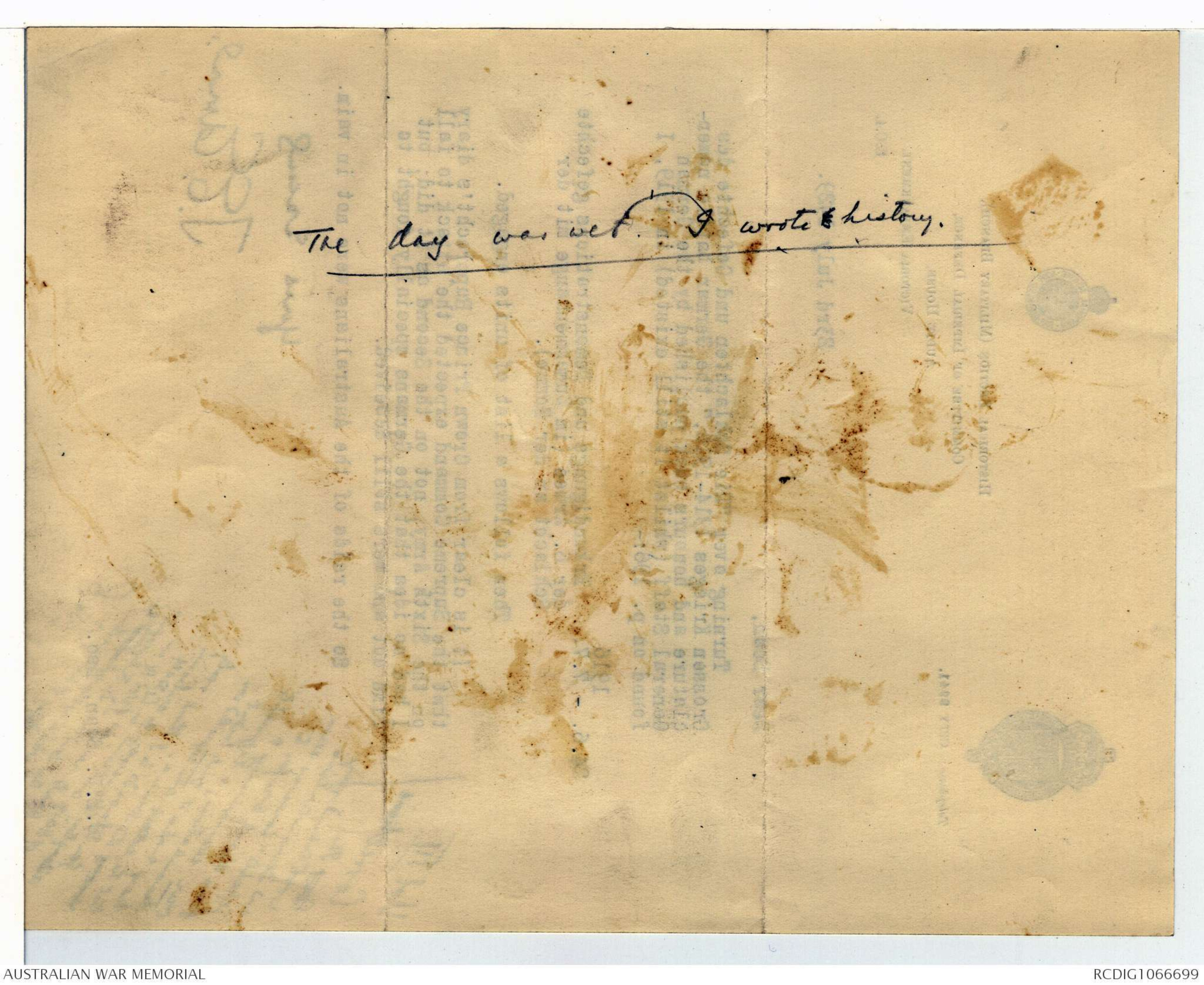
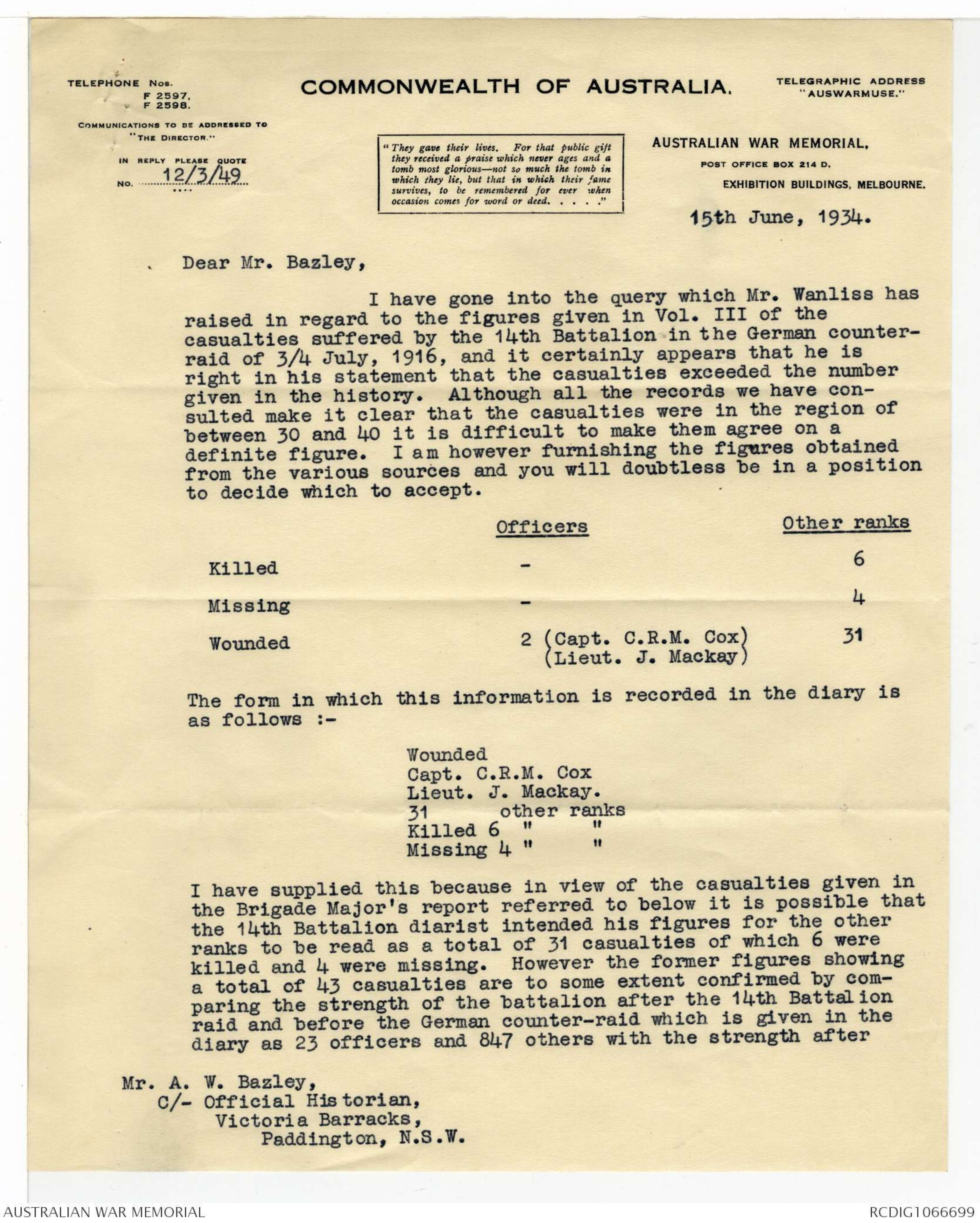
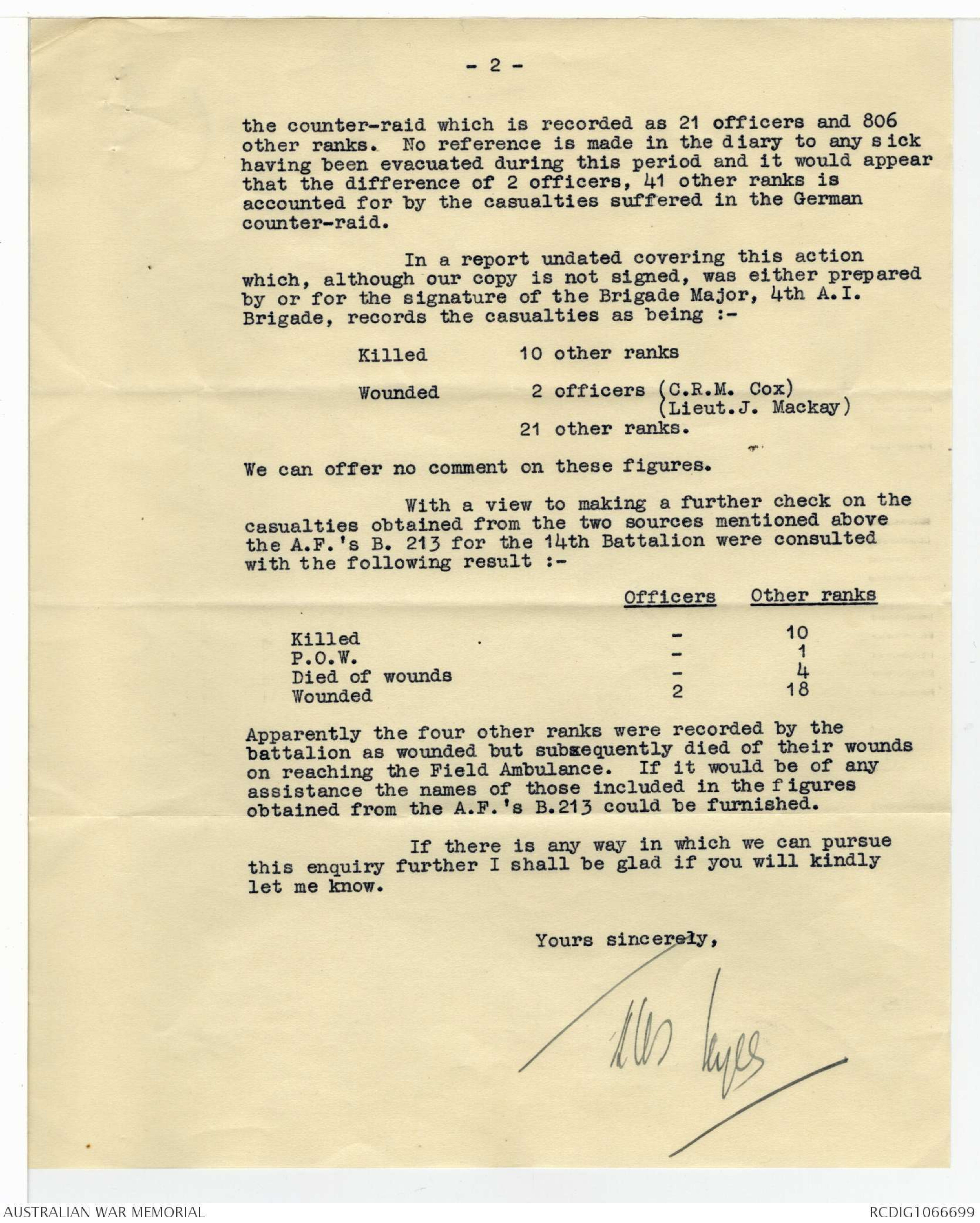
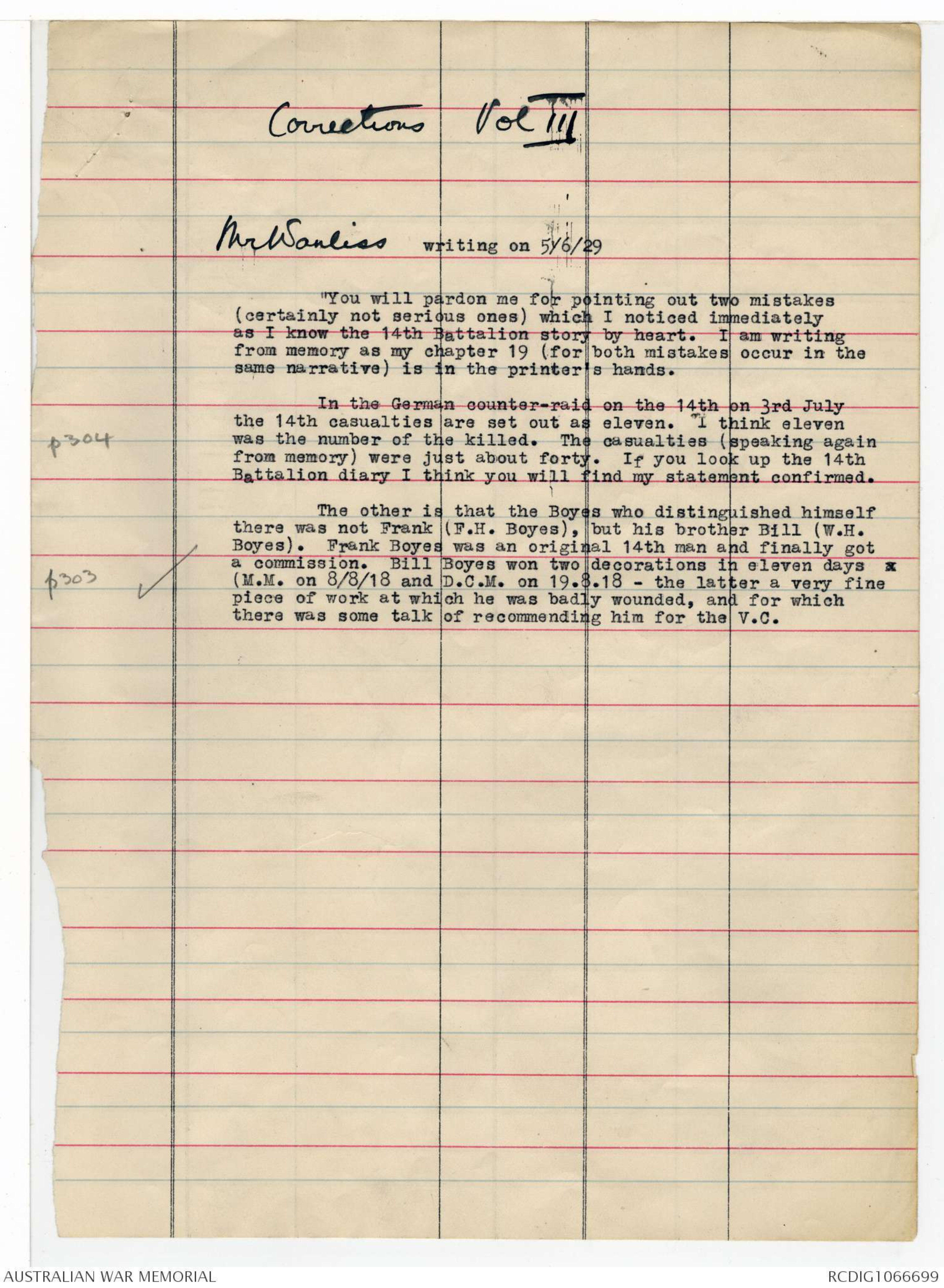
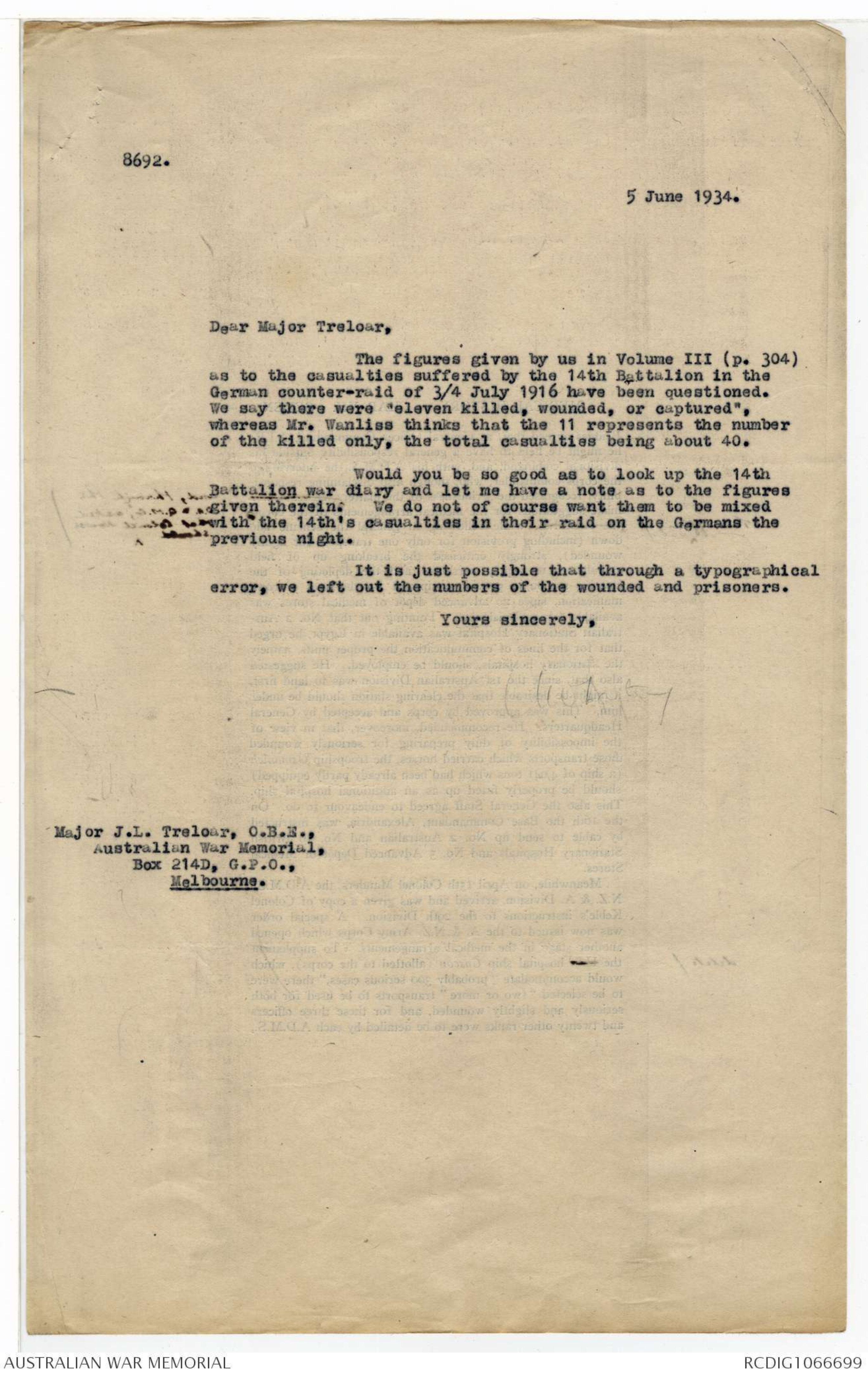
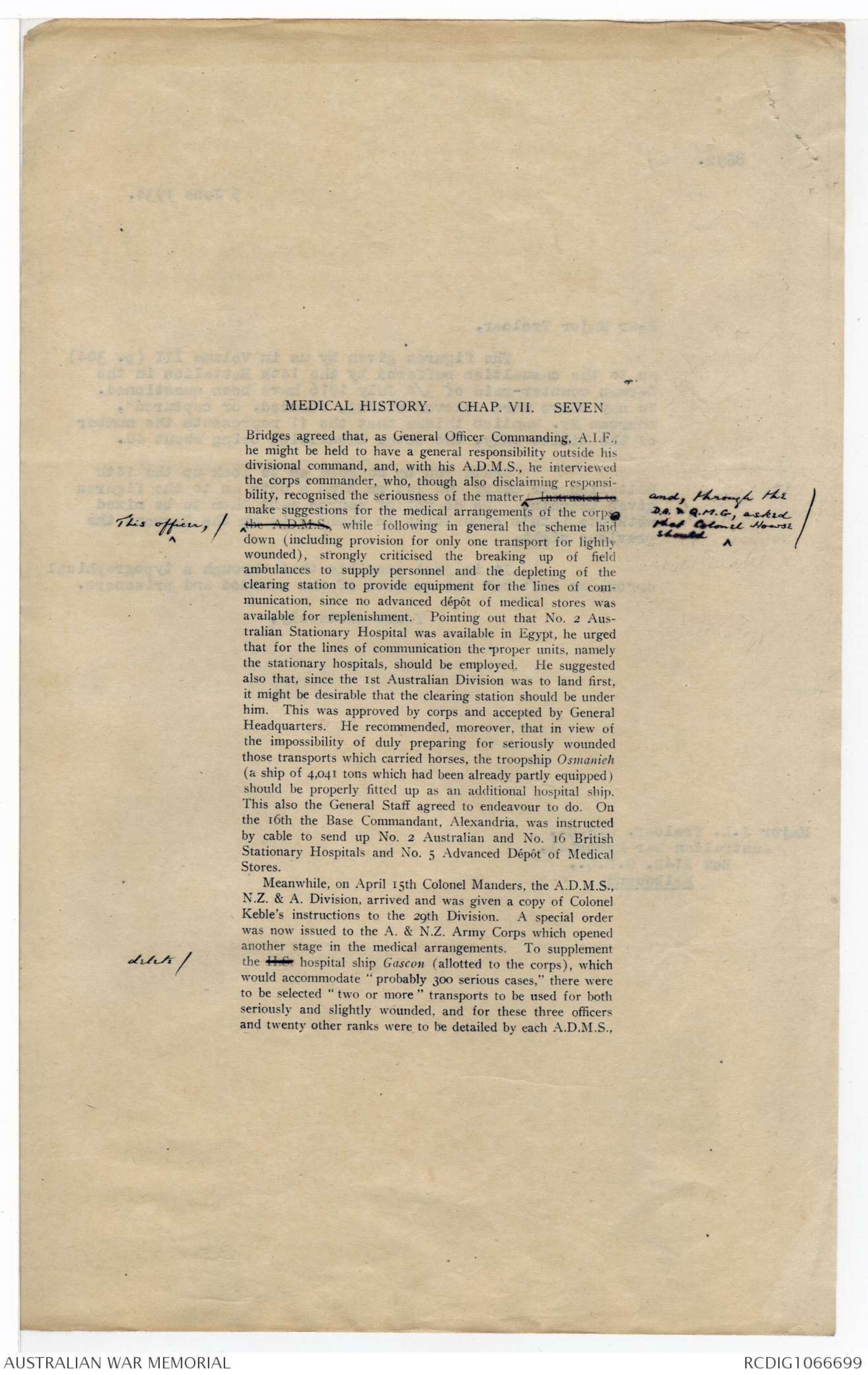
(2)22
The other six were to crawl through wire, first man
through to wait a few seconds and see if others were
coming along O K then drop a bomb into the trench
wait for it to explode then jump in|and every man
for himself. The explosion of the bomb being signal
for bombers on right and left to throw bombs into
the trench at short intervals thus putting a slight
barage on that section of the trench. I being familiar
with the locality through being out on patrol a few
nights previousxxx, was in the lead and on reaching the wire
crawled through making a slight noise, next man doing
likewise. Both of us glanced back and seeing the
others coming up to the wire, we dropped a bomb, xxx
waited for the explosion and jumped in -
A small bomb exploded near us, I got a piece in the
chest. We went down the trench a few yards and bombed
a bay, but could see no one. A few feet further we
came to the junction of the front line and the
comunication trench. Bombs began to fall close to us
we bombed the communication trench and those outside
were keeping a bomb barage on the front trench.
This went on for a short time when a bomb burst close
to us wounding my mate in arm and stomach and me
in the face and throat, knocking me down and partially
stunning me. I soon regained sufficient sence to
know where I was. I saw a man going over the parapet
this gave me a hazy idea that I should do the same,
I stumbled out of the trench and into the wires.
Could hear the Fritzs' coming along his duck boards-
Fear gave me enough strength to tear myself out of
wire and roll into a shell hole at about the same
time as one of his bombs. This wounded me in the
leg and hip. I was bruoght in later and attended to
by a Doctor. While he was dressing me I was closely
questioned by two or three officers. They wanted
the smallest details concerning what I had seen and
and particularly so about the formation and condition
of the trench. I did not see any others of party
in trench, believe that they did not get in but was
too busy with my own affairs to be certain. Cannot
supply any names with any certainty.-
D Coy, of 1st. Bat. Raided shortly after us but was
unsuccessful, several being wounded before they got
to the wire.
(3)
Owing to being very busy at the office I could not
get time to get my mimnd to this, have made several
attempts to complete it but have managed it at last -
It is rather long winded and clumsy, but having
nothing very defenite to state it is rather difficult
to set it out properly. So I am telling you the whole yarn,
not for a moment thinking that my own personal experience
has any bearing on the matter but hoping that some
of the detail may be of use to you. -
Will be only to pleased to give you a ring next time
that I am in Town. Last time we were down Ada Tried
to ring Effie but was unsuccessful, I was in hospital and
everything was generally upset, otherwise we would
have seen you both.
If at any time either or both of you are considering
a little quite life there is always plenty of room
here and we would be delighted to have you
Kindest regards to you both also the Seasons Greetings
from us both
Yours Sincerely
H OBrien
P.S.
Started this about three weeks ago
OB
19/12/27
HISTORICAL SECTION (MILITARY BRANCH),
COMMITTEE OF IMPERIAL DEFENCE,
AUDIT HOUSE
VICTORIA EMBANKMENT,
E.C.4
Telephone: CITY 9941.
23rd July 1929.
Dear Bean,
Turning over "Die Schlachten und Gefechte des
Grossen Krieges 1914-1918, the German battle nomen-clature and honours book published by the German
General Staff (whilst it still existed) in 1919, I
found on p. 196: -
1916
24.6. - 7.7. Erkundigungs und Demonstrations gefechte
der 6. Armee (im Zusammenhange mit der
Schlacht an der Somme).
Then follows a list of units engaged.
It is clear from Crown Prince Rupprecht's diary
that the Supreme Command expected the attack to fall
on the Sixth Army, not on the Second as it did; but
I had no idea that the Germans specially fought to
find out and were still deceived.
So the raids of the Australians were not in vain.
Yours Sincerely
J. E. Edmond
[*Vol III
Corrections
But The words "Erkundigungs
und Demonstrations
Gefechte" however seem
to me clearly to refer to
our reconnaissance &
demonstrations ; & Rupprecht's
diary notes it quite evident
that the attack was expected on
xxxx of the Somme
Gen Edmonds is I think really
attempting to assuage a criticism
of Haig contained in Liddell
Harts review of Vol III in
the London D. Telegraph",
which appeared about on the
day of his letter.
C E W B *]
C. E. W. Bean, Esq.
The day was wet. I wrote x history.
TELEPHONE Nos
F 2597
F 2598
COMMONWEALTH OF AUSTRALIA.
TELEGRAPHIC ADDRESS
"AUSWARMUSE"
COMMUNICATONS TO BE ADDRESSED TO
"THE DIRECTOR."
IN REPLY PLEASE QUOTE
NO. 12/3/49
"They gave their lives. For that public gift
they received a praise which never ages and a
tomb most glorious - not so much the tomb in
which they lie, but that in which their fame
survives to be remembered for ever when
occasion comes for word or deed . . . ."
AUSTRALIAN WAR MEMORIAL.
POST OFFICE BOX 214 D.
EXHIBITION BUILDINGS, MELBOURNE.
15th June, 1934.
Dear Mr. Bazley,
I have gone into the query which Mr. Wanliss has
raised in regard to the figures given in Vol. III of the
casualties suffered by the 14th Battalion in the German counter-
raid of 3/4 July, 1916, and it certainly appears that he is
right in his statement that the casualties exceeded the number
given in the history. Although all the records we have consulted
make it clear that the casualties were in the region of
between 30 and 40 it is difficult to make them agree on a
definite figure. I am however furnishing the figures obtained
from the various sources and you will doubtless be in a position
to decide which to accept.
| Officers | Other ranks | ||
| Killed | - | 6 | |
| Missing | - | 4 | |
| Wounded | 2 |
(Capt. C.R.M. Cox) (Lieut. J. Mackay) |
31 |
The form in which this information is recorded in the diary is
as follows :-
Wounded
Capt. C.R.M. Cox
Lieut. J. Mackay.
31 other ranks
Killed 6 " "
Missing 4 " "
I have supplied this because in view of the casualties given in
the Brigade Major's report referred to below it is possible that
the 14th Battalion diarist intended his figures for the other
ranks to be read as a total of 31 casualties of which 6 were
killed and 4 were missing. However the former figures showing
a total of 43 casualties are to some extent confirmed by comparing
the strength of the battalion after the 14th Battalion
raid and before the German counter-raid which is given in the
diary as 23 officers and 847 others with the strength after
Mr. A. W. Bazley.
C/- Official Historian,
Victoria Barracks
Paddington, N.S.W.
- 2 -
the counter-raid which is recorded as 21 officers and 806
other ranks. No reference is made in the diary to any sick
having been evacuated during this period and it would appear
that the difference of 2 officers, 41 other ranks is
accounted for by the casualties suffered in the German
counter-raid.
In a report undated covering this action
which, although our copy is not signed, was either prepared
by or for the signature of the Brigade Major, 4th A. I.
Brigade, records the casualties as being:-
| Killed | 10 other ranks | |
| Wounded | 2 Officers |
(C.R.M. Cox) (Lieut.J. Mackay) |
| 21 other ranks. |
We can offer no comment on these figures.
With a view to making a further check on the
casualties obtained from the two sources mentioned above
the A.F.'s B. 213 for the 14th Battalion were consulted
with the following result:-
| Officers | Other ranks | |
| Killed | - | 10 |
| P.O.W. | - | 1 |
| Died of wounds | - | 4 |
| Wounded | 2 | 18 |
Apparently the four other ranks were recorded by the
battalion as wounded but subsequently died of their wounds
on reaching the Field Ambulance. If it would be of any
assistance the names of those included in the figures
obtained from the A.F.'s B.213 could be furnished.
If there is any way in which we can pursue
this enquiry further I shall be glad if you will kindly
let me know.
Yours sincerely,
[[?]]
Corrections Vol III
Mr Wanliss writing on 5/6/29
"You will pardon me for pointing out two mistakes
(certainly not serious ones) which I noticed immediately
as I know the 14th Battalion story by heart. I am writing
from memory as my chapter 19 (for both mistakes occur in the
same narrative) is in the printer hands.
In the German counter-raid on the 14th on 3rd July
the 14th casualties are set out as eleven. I think eleven
was the number of the killed. The casualties (speaking again
from memory) were just about forty. If you look up the 14th
Battalion diary I think you will find my statement confirmed.
[*p 304*]
The other is that the Boyes who distinguished himself
there was not Frank (F.H. Boyes), but his brother Bill (W.H.
Boyes). Frank Boyes was an original 14th man and finally got
a commission. Bill Boyes won two decorations in eleven days x
(M.M. on 8/8/18 and D.C.M. on 19.8.18 - the latter a very fine
piece of work at which he was badly wounded, and for which
there was some talk of recommending him for the V.C.
[*p 303*]
8692.
5 June 1934.
Dear Major Treloar,
The figures given by us in Volume III (p. 304)
as to the casualties suffered by the 14th Battalion in the
German counter-raid of 3/4 July 1916 have been questioned.
We say there were "eleven killed, wounded, or captured",
whereas Mr. Wanliss thinks that the 11 represents the number
of the killed only, the total casualties being about 40.
Would you be so good as to look up the 14th
Battalion war diary and let me have a note as to the figures
given therein. We do not of course want them to be mixed
with the 14th's casualties in their raid on the Germans the
previous night.
It is just possible that through a typographical
error, we left out the numbers of the wounded and prisoners.
Yours sincerely,
[[?]]
Major J.L. Treloar, O.B.E.,
Australian War Memorial,
Box 214D, G.P.O.,
Melbourne.
MEDICAL HISTORY. CHAP. VII. SEVEN
Bridges agreed that, as General Officer Commanding, A.I.F.,
he might be held to have a general responsibility outside his
divisional command, and, with his A.D.M.S, he interviewed
the corps commander, who though also disclaiming responsibility,
recognised the seriousness of the matter ^ Instructed to
[*and, through the
D.A. & Q.M.G, asked
that Colonel Howse
should ^*]
make suggestions for the medical arrangements of the corps.
[*This officer,
^*]
^ the A.D.M.S. while following in general the scheme laid
down (including provision for only one transport for lightly
wounded), strongly criticised the breaking up of field
ambulances to supply personnel and the depleting of the
clearing station to provide equipment for the lines of communication,
since no advanced dépôt of medical stores was
available for replenishment. Pointing out that No. 2 Australian
Stationary Hospital was available in Egypt, he urged
that for the lines of communication the proper units, namely
the stationary hospitals, should be employed. He suggested
also that, since the 1st Australian Division was to land first,
it might be desirable that the clearing station should be under
him. This was approved by corps and accepted by General
Headquarters. He recommended, moreover, that in view of
the impossibility of duly preparing for seriously wounded
those transports which carried horses, the troopship Osmanich
(a ship of 4,04I tons which had been already partly equipped)
should be properly fitted up as an additional hospital ship.
This also the General Staff agreed to endeavour to do. On
the 16th the Base Commandant, Alexandria, was instructed
by cable to send up No. 2 Australian and No. 16 British
Stationary Hospitals and No. 5 Advanced Dépót of Medical
Stores.
Meanwhile, on April 15th Colonel Manders, the A.D.M.S.
NZ. & A. Division, arrived and was given a copy of Colonel
Keble's instructions to the 29th Division. A special order
was now issued to the A. & NZ. Army Corps which opened
another stage in the medical arrangements. To supplement
[*delete*]
the H.S. hospital ship Gascon (allotted to the corps), which
would accommodate, probably 300 serious cases," there were
to be selected "two or more" transports to be used for both
seriously and slightly wounded, and for these three officers
and twenty other ranks were to be detailed by each A.D.M.S
 Sam scott
Sam scottThis transcription item is now locked to you for editing. To release the lock either Save your changes or Cancel.
This lock will be automatically released after 60 minutes of inactivity.